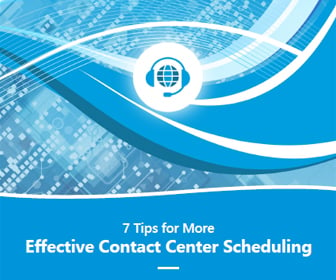Workforce Management Featured Article
Workforce Management Apps Improve Call Center Scheduling
Over the years, more and more workforce management (WFM) offerings have become available than ever before, and they vary in complexity, ease of use, functionality and accuracy. Contact centers of every size can now find a WFM package that meets their needs, helping to improve call center management and scheduling.
WFM tools are used by contact center managers to forecast inbound and outbound volumes and then schedule the right number of agents to respond to the interactions. WFM applications are some of the most important f the contact center productivity tools. They are also considered critical in many operating environments because they are essential for effective agent management. However, the complexity of many of the earlier tools caused the adoption of WFM to be slower than it could have been.
However, according to a recent report by DMG Consulting, this is changing due to a major shift in WFM applications. Now that so many WFM products are available in the cloud, they are easier to implement. Contact center managers can try an application and, if they don't like it, cancel their contract and move on. The cloud is helping to change the dynamics of the WFM sector because it has made this application more accessible and affordable.
Changes in the contact center workforce are also increasing the need for WFM solutions. As younger workers - known as "Millennials," or members of Generation Y - enter the contact center workforce, they are altering the structure. Millennials are different from Boomers or Generation X as they have different expectations of employers and what they are willing to give of themselves to their jobs according to the report. They are protective of their work-life balance and are not willing to sacrifice their personal lives for their organization.
It was never a good idea to ask agents to alter their schedules to meet the changing needs of the organization, but this scenario was common. In the past, employees made an effort to accommodate these requests, but not anymore. The report explains that Millennials do not see the benefit of sacrificing personal commitments for companies that are not committed to them, and as a result, WFM software has become a requirement that enables contact centers to find a balance between the need to optimize departmental performance and their staff's need to prioritize their personal lives.
Ultimately, this means that if you have not updated your WFM tools in the past three years, it's time. This includes investing in a scheduling functionality that allows the prioritizing of agent preferences over department optimization, self-service capabilities that allow agents to pick schedules, capabilities to approve the changes on an automated basis.
If you're satisfied with your current WFM system, then it makes sense to upgrade to a newer release with advanced features. However, if a new release is not available, then take a look at the market competitors, the report suggests.
Although WFM tools are important productivity tools, they are also essential for providing an excellent customer experience. Contact center managers would not know how many agents they need for responding to interactions on a timely basis without them. In the past, these applications were so complex that it was not worth the effort to implement them unless you had hundreds of agents. But with the new generation of WFM tools, there is an emphasis on ease of use.
Want to learn more about the latest in communications and technology? Then be sure to attend ITEXPO West 2012, taking place Oct. 2-5, in Austin, TX. Stay in touch with everything happening at ITEXPO (News - Alert). Follow us on Twitter.
Edited by Rachel Ramsey







